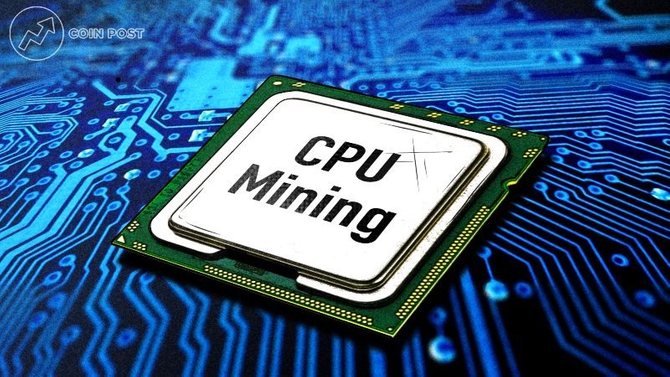
Probably, every person studying the topic of mining thought about how profitable the extraction of cryptocurrencies using a CPU is. After all, the most popular coins are now received when using video cards or special devices.
Mining on the CPU is available to almost every owner of a personal computer. However, due to the ever-increasing complexity of the network of popular cryptocurrencies, such as Bitcoin, Ethereum, Litecoin, and so on, their mining on the CPU has become unprofitable.
But this does not mean that it is completely impossible to earn on this type of mining. In this article, we will talk about current CPU for cryptocurrency mining, profitability and talk about the profitability of this type of token production.
- What is CPU Mining
- CPU Server Mining
- How to Mine On the CPU
- Mining on the Xeon CPU
- How to Choose a CPU for Mining
- CPU Mining Calculators
- How to Choose a Program for Mining on the CPU
- Mining On The CPU and On The Video Cards — Differences
- What Cryptocurrencies are Profitable to Mine on the CPU in 2020
- Pros and Cons of CPU Mining
- What is Better to Mine on the CPU in 2020
- Prospects for Mining on the CPU in 2020
What is CPU Mining

Mining on a CPU is the process of mining cryptocurrency by finding a hash using the processing power of a central processor (CPU) and assigning it to a block inside the cryptocurrency blockchain.
For the first time, mining was launched precisely on the central processor by the creator of bitcoin Satoshi Nakamoto. It was with the help of the CPU that Satoshi mined his 1 million BTC. At the dawn of the cryptocurrency era, when bitcoin cost a few cents, mining even on a very average CPU was very efficient, the only thing is that the price of a few cents bitcoin then compensated for this phenomenon.
Mining on the CPU in theory is possible with cryptocurrencies supporting the following algorithms:
- SHA-256;
- X11;
- Ethash
- Scrypt
- Equihash.
In theory, because in practice in the future, with the development of the cryptocurrency industry, the mining baton was first taken over by video cards, and after ASIC miners (Application Specific Integrated Circuit) — specialized high-performance devices. The computing power they provided left both the CPU and video cards out of the game (with the exception of mining those cryptocurrencies that work on Ethash or Zhash algorithms).
CPU Server Mining

The server CPU is a more productive and stable modification of the usual central processor, designed to work in the conditions of data centers and with a large network load.
How is a server CPU different from a regular one? In fact, the server processor has several differences from the usual desktop processor:
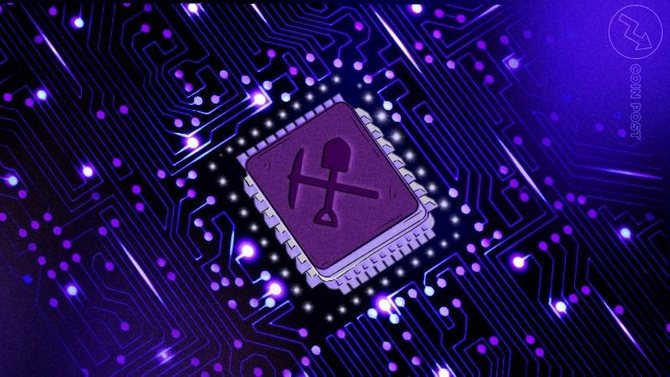
Another difference between the server modification and the desktop one is in a different principle of operation. The CPU server is designed to work with a powerful stream of network data, in fact in relative multitasking mode, while the desktop version works in multithreading mode with many small tasks.
Mining on server CPU also has a slightly higher efficiency compared to mining cryptocurrency on a conventional processor including because of the more cache in the second level of the server modification.
The server CPU is good for cryptocurrency mining, due to its greater reliability and performance, but only in comparison with a conventional desktop processor, but video cards and ASIC still bypass it in terms of performance.
In addition, it should be understood that the server CPU consumes more power and costs much more than the desktop.
On the server CPU, you can mine all cryptocurrencies that support the CryptoNote and CryptoNight encryption algorithms.
How to Mine On the CPU

To start mining on the CPU, you need to do the following (for example, mining Monero):
- Step 1. Download the program for mining.
- Step 2. Open a wallet to store mined coins.
- Step 3. Choose a suitable mining pool and register in it.
- Step 4. To start mining on the CPU, you will need to create a file with the BAT extension (this is a regular file with the TXT extension, in which you need to change the extension to BAT).
- Step 5. For an example, we took the nanopool pool. Therefore, the following should be written in the file: NsCpuCNMiner64.exe -o stratum + tcp: //xmr-eu1.nanopool.org: 14444-u Your address is Monero -p x -pow7 1 -t 2, where 2 is the number of threads for mining Monero.
- Step 6. Save the file and run.
- Step 7. Mining has begun.
Note that the number of threads you need to choose based on the capabilities of your CPU. Each stream needs about 2 MB of cache. For example, on the Intel CPU i7-7700K, the total amount of cache memory is 8 MB. Accordingly, it makes no sense to run more than 4 threads if you plan to use the computer not only for mining, but also for ordinary use.
Mining on the Xeon CPU

The Intel Xeon CPU family is the server line of productive CPU models known for their reliability and performance.
In some cases, mining on Intel Xeon server CPU is significantly ahead of the same activity on the Intel i7 and i9 family of desktop processors. So, the server model Intel Xeon E5-2650 shows a decent result for the CPU at 143 kH / s, while the desktop model Intel Core i7-3960X shows only 101 kH / s.
For comparison: the Nvidia GeForce RTX 2080 Ti video card demonstrates a result of 52.5 Mh / s.
Setting up the mining procedure on the server CPU is no different from setting up desktop models. You need to run the graphical interface of the program, specify the necessary data there and start the mining process.
How to Choose a CPU for Mining

Choosing a CPU for mining, we are faced with two companies – AMD and Intel. And if you consider that the “reds” have recently released multi-threaded CPU, they are the best choice for mining. But, let's look at the CPU from both companies:
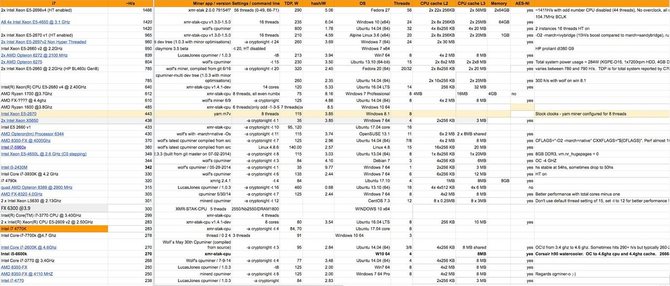
** We’ll clarify that even though AMD claims improved performance of the new line, in fact it gives the same power when mining. And in the case of some algorithms, it’s worse than previous models.
*** The presented profitability and payback are calculated without taking into account the cost of electricity.
**** Payback periods, as well as profitability, depend on the rate of cryptocurrencies and USD.
It is also worth considering that new CPU from Intel, whose cost is much higher than $300, are not recommended for mining. First, the payback period is much more than two years. Secondly, the processor should work all this time, which means that there is a high risk of breakdown.
And if you consider that in addition to the processor you need the same powerful motherboard and cooling system, the new equipment will not pay off for sure.
If we talk about server CPU, then mining on them is beneficial only if they support encryption using the AES (Advanced Encryption Standard) algorithm. For example, even a new CPU that does not have built-in AES will have lower performance than the old Pentium or Intel i3, but with support for this function.
CPU Mining Calculators

Mining calculators on the CPU provide information with a detailed calculation of the profitability of cryptocurrency mining. As a rule, these are the same online platforms that calculate the cost of mining for video cards and ASICs. Based on certain algorithms and cryptocurrency quotes, these services calculate the profitability of mining in real time, i.e., at the current rate of the cryptocurrency.
Services are arranged according to a simple principle: you enter the name of the model of the CPU, the cost of electricity in your region and get the calculation for the necessary cryptocurrencies, usually with detailed information about which one is the most profitable in a given time period.
The list of the most convenient calculators for mining on the CPU below.
NiceHash
An excellent mining calculator that initially provides calculations for the associated cloud mining and marketplace service with trading remote mining capabilities. Simple, intuitive and convenient. The service supports as many as 24 algorithms.
As an example of the use of a mining calculator, we will calculate mining on two different central processors, two desktop ones from the manufacturers Intel and AMD, and one server using the NiceHash calculator.
We will take the best models with high performance for the most current picture.
First example: AMD's top-end CPU — AMD CPU Threadripper 2900WX.

As we can see, mining even on a very powerful processor, if it provides profitability, is very relative, especially against the background of the same performance from video cards and ASICs.
The second example: the central CPU from Intel — Intel CPU i9-9980XE:
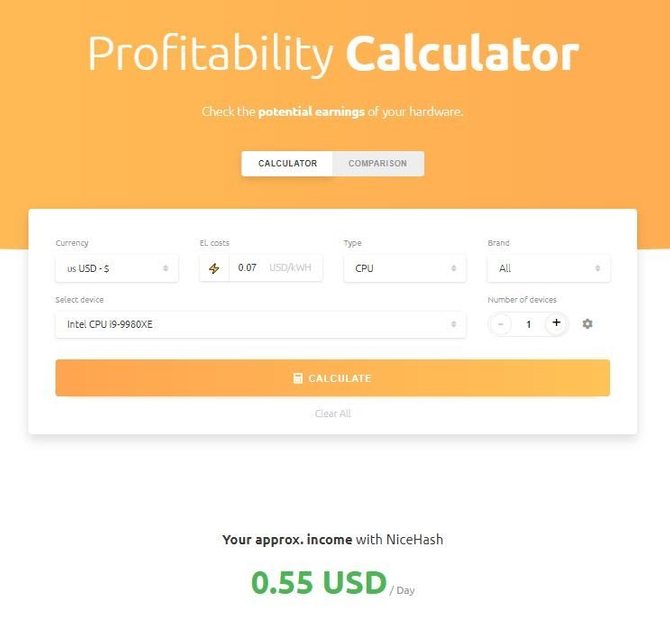
The screenshot shows that in the case of even such a powerful CPU, mining on central processors — if it has a profitability, it is very relative.
My Crypto Buddy
An excellent calculator for cryptocurrency mining also with the ability to calculate the complexity of mining, determine commissions from large mining pools. All this data is provided to the user as part of an advanced approach in the original report.
CryptoCompare
Convenient and intuitive mining calculator. It provides users with only three fields, with a hashrate for mining equipment, its energy consumption and the price of electricity, filling in which, users will receive the necessary information on the profitability of mining.
How to Choose a Program for Mining on the CPU

Programs for mining on the CPU act as an intermediary between the user equipment, the mining pool and the blockchain of the selected cryptocurrency.
It is worth choosing time-tested mining programs and downloading them only from the official resource, as extraneous sources can provide the user with infected software for hidden mining.
Reliable programs for mining on the central CPU are described below.
Claymore’s CryptoNote Windows CPU Miner
An excellent mining client running on the CryptoNote algorithm with a wide range of settings and no commission for the developer. The program provides all the possibilities for mining on the central CPU of both desktop and server modifications.
XMRig Miner
This mining client provides standard options for setting up mining on the central CPU.
For successful work, you must provide the program administrator access. XMRig miner also allows you to configure the number of threads for the central CPU, which allows you to more accurately configure mining.
However, it should be noted that each stream requires a 2 MB cache in the second level, therefore, not all middle-class processors, such as the Intel CPU i7-7700K, support a mode with more than 4 threads.
Mining On The CPU and On The Video Cards — Differences
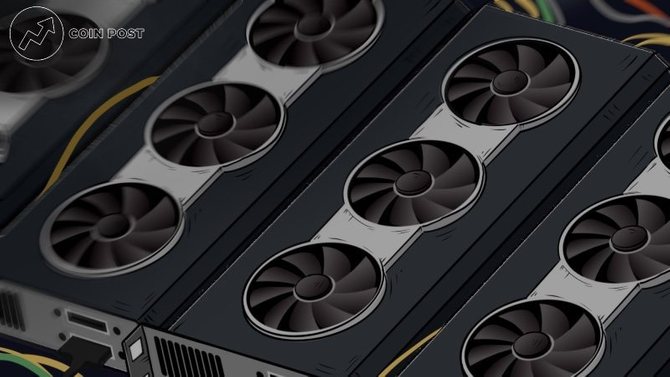
Probably, one of the main differences between cryptocurrency mining on the CPU and video cards is too little profit or no profit at all. But at the same time, mining on the CPU is more affordable, since even on average personal computers there is a relatively good processor.
The CPU is responsible for the software tasks that control all the components of a personal computer, laptop or any other device. The CPU to some extent manages all the components, makes decisions and issues commands to the programs.
The GPU, in turn, is responsible for processing graphics and displaying an image on a
monitor connected to a personal computer or other equipment. Unlike the CPU, the video card does not issue any commands, but, on the contrary, executes them.
At the same time, video cards use a faster type of memory compared to CPU, which in the context of mining means high throughput in parallel computing.
It turns out that even from a technical point of view, the difference between the CPU and the video card is huge. And when it comes to mining, performance plays a significant role.
What Cryptocurrencies are Profitable to Mine on the CPU in 2020

In 2020, cryptocurrency mining on the CPU is almost unprofitable, due to the capture of the mining industry by more productive ASICs and video cards for mining.
Is Mining Possible On The Bitcoin CPU
Mining Bitcoin cryptocurrencies (BTC) on the CPU is unprofitable due to the high complexity of the network and the huge number of ASICs working in it.
Is It Worth to Mine Ethereum On The CPU
Cryptocurrency Ethereum (ETH) as one of the most popular coins is of great interest to miners, but like Bitcoin, due to the high complexity of the network, it is unprofitable if it is mined on a CPU.
How to Mine Monero On a CPU

The anonymous cryptocurrency Monero (XMR) is also popular with miners, but unlike the first two, it can be mined on CPU. Monero can be successfully mined on the CPU, if the miner is the owner of powerful processors such as Intel CPU i7-9750H or Intel CPU i9-9980XE and is better in a large enough quantity.
The Profitability of Mining Dogecoin on the CPU
Cryptocurrency meme Dogecoin (DOGE) is quite possible to mine, if the user has several CPU of the Intel CPU i9-9980XE level and is connected to the mining pool.
Is it Possible to Mine Zcash on the CPU
Another anonymous cryptocurrency, Zcash (ZEC), is often used by hackers, but since it is accepted on a number of large cryptocurrency exchanges, it is also interesting to miners. However, its network complexity and cost in the market is such that it is simply unprofitable to mine it on the CPU.
Pros and Cons of CPU Mining

Pros:
Cons:
What is Better to Mine on the CPU in 2020

But as an option, mining of little-known cryptocurrencies is possible, with their subsequent storage in the hope of sales during the pump on the cryptocurrency exchange. However, it should be understood that some cryptocurrencies may remain in your wallet without the ability to exchange them for fiat money. This is due to both the lack of demand for such cryptocurrencies and the reluctance of cryptocurrency exchanges to list such coins.
It is also worth saying that mining on the CPU in 2020, although possible, is, compared to video cards, and even more so with ASIC, brings very little profit. Even the most powerful processor is inferior to the GPU.
Depending on the number of cores, one CPU core can process four 32-bit instructions per clock (SSE) or eight 32-bit instructions per clock (AVX). In turn, the video card is capable of processing 3200 32-bit instructions per cycle. Thus, the performance of the GPU is hundreds of times higher than the CPU.

Most blockchains also use adaptation mechanisms for computational complexity so that the time spent by each block is constant. That is why with the increase in computing power in the network, the complexity of finding blocks also grows.
In this regard, there are only a few cryptocurrencies whose mining on the CPU bring at least some income. Such coins are optimized for mining on CPU, which is associated with an increased level of network security.
To a greater extent, these include coins that operate on the CryptoNote scheme and CryptoNight algorithms (CryptoNightV7, CryptoNightV8, CryptoNightR, CryptoNightHeavy and others).
Other algorithms on which it is theoretically possible to mine cryptocurrency using a CPU:
- SHA-256 (little-known forks of bitcoin);
- X11 (Dash, Pura и others);
- Ethash (Ethereum, Ethereum Classic and other coins on ERC-20);
- Scrypt (Litecoin, Dogecoin others);
- Equihash (Zcash).
Prospects for Mining on the CPU in 2020

To be honest, to call promising mining on the CPU in 2020 is not impossible, but very difficult. Yes, when the cryptocurrency industry was just beginning to develop, even Bitcoin was easily mined on the CPU.
But with the development of this type of mining has almost completely lost its relevance. Especially with the advent of ASIC miners and FPGA devices.
In fact, they completely survive not only cryptocurrency mining on CPU, but video cards are also under the gun.
Of course, it makes sense to get new coins, the network complexity of which is not yet as high as that of popular tokens, and the competition among miners is low. However, there is a risk of stumbling into a scam or simply encountering the difficulties of marketing the mined cryptocurrency.
And if you choose a non-popular coin, you should consider whether it will be popular in the future or whether it will remain among noname projects. And if the exchange rate does not grow even in the long term, then there is no sense in such production.
In this case, it is worth considering more profitable options, such as buying an ASIC miner or building a farm on the GPU. Indeed, every year the complexity of networks will only increase, which means that the requirements for equipment capacity will grow.
Read also:
Cloud Mining: Where to Start and How to Avoid Becoming a Victim of Scam
Mining Calculator: How to Calculate Profitability
Mining on HDD: Features and Setting up Mining on the Hard Drive